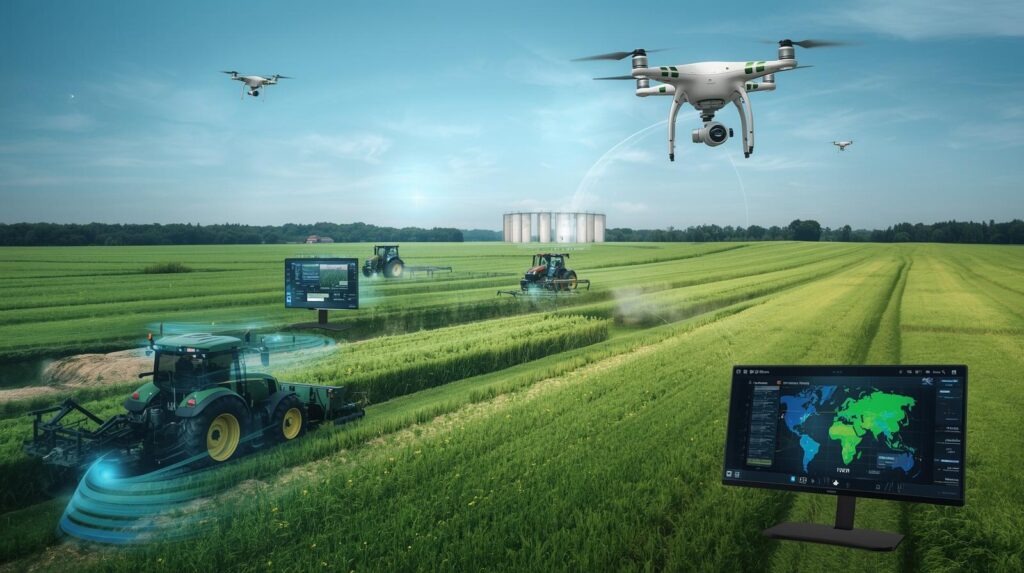The global agricultural sector is undergoing a fundamental transformation as it embraces the power of data, automation, and connectivity. Precision agriculture—also known as smart farming or digital farming—is at the forefront of this change. It leverages technologies such as GPS, IoT, artificial intelligence (AI), big data analytics, and remote sensing to optimize farming operations, enhance crop yields, and promote sustainable agricultural practices. As food demand continues to rise and natural resources become increasingly constrained, precision agriculture is emerging as the key to feeding the next generation efficiently and responsibly.
Download PDF Brochure @ https://www.marketsandmarkets.com/pdfdownloadNew.asp?id=1243

The Concept of Precision Agriculture
Precision agriculture is a data-driven approach that focuses on observing, measuring, and responding to field variability in crops. It empowers farmers with real-time insights into soil conditions, weather patterns, moisture levels, and crop health. By integrating advanced technologies and analytics, it enables farmers to make informed decisions regarding irrigation, fertilization, and pest management. This scientific and data-centric approach ensures that every square meter of farmland receives precisely what it needs to maximize productivity while minimizing waste and environmental impact.
Unlike traditional farming methods that apply uniform inputs across an entire field, precision agriculture enables site-specific management. For instance, sensors placed across fields collect valuable data that can be analyzed to determine where water or nutrients are most needed. Drones and satellite imagery further assist in crop monitoring, identifying stress areas, and improving resource allocation. This integration of technology and agriculture is redefining the way farming is practiced across the world.
Market Growth and Key Drivers
The precision agriculture market is witnessing robust growth due to the rising global population, increasing food demand, and the need for efficient resource management. According to market forecasts, the precision agriculture industry is expected to experience a strong compound annual growth rate (CAGR) over the coming years. The primary growth drivers include advancements in IoT-based farming systems, increased adoption of smart sensors, and growing awareness about sustainable agricultural practices.
Additionally, government initiatives promoting digital transformation in agriculture are further accelerating adoption. Many countries are offering financial incentives, training programs, and research support to encourage farmers to use advanced technologies. The integration of cloud computing, 5G connectivity, and AI is also enhancing the scalability and efficiency of precision farming solutions, making them accessible to both large-scale and smallholder farmers.
Key Technologies Powering Data-Driven Farming
Several technologies form the backbone of precision agriculture. GPS and Geographic Information Systems (GIS) play a crucial role in mapping fields, tracking machinery, and guiding automated equipment with pinpoint accuracy. Internet of Things (IoT) sensors monitor real-time parameters such as soil moisture, nutrient levels, and temperature, transmitting data to cloud-based platforms for analysis.
Unmanned Aerial Vehicles (UAVs) or drones have become indispensable tools for modern farmers. They capture high-resolution images that help assess crop health, detect diseases early, and plan precise spraying operations. AI and machine learning algorithms process vast amounts of data, providing actionable insights and predictive models that help farmers anticipate challenges and optimize yield outcomes. Meanwhile, variable rate technology (VRT) automates the precise application of inputs, ensuring efficient resource utilization and cost savings.
Regional Market Insights
North America currently leads the global precision agriculture market, thanks to high technology adoption, advanced farming infrastructure, and strong government support. The region’s focus on sustainable farming and increasing farm automation has made it a global hub for agritech innovation. Europe follows closely, driven by strict environmental regulations and initiatives aimed at reducing chemical use and carbon emissions in farming.
The Asia Pacific region is expected to exhibit the fastest growth in the coming years. Countries such as India, China, and Japan are investing heavily in digital agriculture initiatives to address food security challenges and improve productivity. The rapid penetration of smartphones, improving rural internet connectivity, and the proliferation of agritech startups are key factors contributing to the region’s market expansion.
Challenges to Overcome
Despite its tremendous potential, the precision agriculture market faces several challenges. High initial investment costs for advanced equipment, lack of technical knowledge among farmers, and inadequate data management infrastructure are some of the key barriers. Many small and medium-sized farmers, especially in developing economies, find it difficult to justify the expense of adopting precision technologies.
Moreover, the integration and interpretation of data from multiple sources require sophisticated software systems and technical expertise. Ensuring data privacy and cybersecurity is also a growing concern as farms become more digitally connected. Addressing these challenges through education, financial support, and affordable technological solutions will be critical for the widespread adoption of precision agriculture.
The Future of Precision Agriculture
The future of farming is undoubtedly data-driven. With rapid advancements in AI, robotics, and cloud computing, the precision agriculture market is set to evolve into an even more intelligent ecosystem. Fully autonomous tractors, AI-powered pest detection systems, and blockchain-based supply chain traceability will define the next phase of agricultural innovation.
In the coming decade, the integration of real-time data analytics and predictive intelligence will enable farmers to optimize every aspect of production—from planting to harvesting. Sustainable agriculture practices will become the norm, as precision technologies help reduce water consumption, pesticide use, and greenhouse gas emissions.